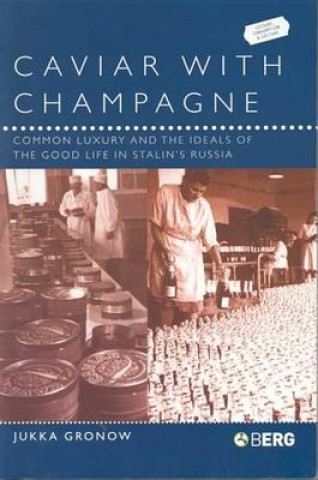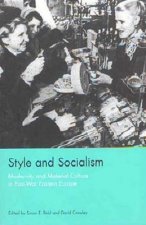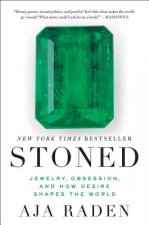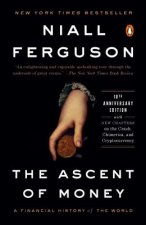
Kód: 01259278
Caviar with Champagne
Autor Jukka Gronow
'Life has become more joyous, comrades.' Josef Stalin, 1936Stalin's Russia is best known for its political repression, forced collectivization and general poverty. Caviar with Champagne presents an altogether different aspect of S ... celý popis
- Jazyk:
 Angličtina
Angličtina - Vazba: Pevná
- Počet stran: 256
Nakladatelství: Bloomsbury Publishing, 2003
- Více informací o knize

Mohlo by se vám také líbit
-

BX-MADE IN ABYSS V01-05 VOX SET
1351 Kč -

This Book Will Make You Dangerous
357 Kč -

Don Quijote De LA Mancha
582 Kč -

Pełny kurnik
179 Kč -

Essential Elements for Strings
194 Kč -

A. Lange and Sohne Highlights
611 Kč -

Stranger Things: The Ultimate Pop-Up Book
1716 Kč -

Caviar with Champagne
1460 Kč -

Stalinism
1816 Kč -

Style and Socialism
1641 Kč -

Ridley Road
265 Kč -

Geodesy
1866 Kč -

Sociology Of Taste
1816 Kč -

Everyday Life in Russia Past and Present
922 Kč
Darujte tuto knihu ještě dnes
- Objednejte knihu a zvolte Zaslat jako dárek.
- Obratem obdržíte darovací poukaz na knihu, který můžete ihned předat obdarovanému.
- Knihu zašleme na adresu obdarovaného, o nic se nestaráte.
Více informací o knize Caviar with Champagne
Nákupem získáte 487 bodů
 Anotace knihy
Anotace knihy
'Life has become more joyous, comrades.' Josef Stalin, 1936Stalin's Russia is best known for its political repression, forced collectivization and general poverty. Caviar with Champagne presents an altogether different aspect of Stalin's rule that has never been fully analyzed - the creation of a luxury goods society. At the same time as millions were queuing for bread and starving, drastic changes took place in the cultural and economic policy of the country, which had important consequences for the development of Soviet material culture and the promotion of its ideals of consumption.The 1930s witnessed the first serious attempt to create a genuinely Soviet commercial culture that would rival the West. Government ministers took exploratory trips to America to learn about everything from fast food hamburgers to men's suits in Macy's. The government made intricate plans to produce high-quality luxury goods en masse, such as chocolate, caviar, perfume, liquor and assorted novelties. Perhaps the best symbol of this new cultural order was Soviet Champagne, which launched in 1936 with plans to produce millions of bottles by the end of the decade. Drawing on previously neglected archival material, Jukka Gronow examines how such new pleasures were advertised and enjoyed. He interprets Soviet-styled luxury goods as a form of kitsch and examines the ideological underpinnings behind their production.This new attitude toward consumption was accompanied by the promotion of new manners of everyday life. The process was not without serious ideological contradictions. Ironically, a factory worker living in the United States - the largest capitalist society in the world - would have been hard-pressed to afford caviar or champagne for a special occasion in the 1930s, but a Soviet worker theoretically could (assuming supplies were in stock). The Soviet example is unique since the luxury culture had to be created entirely from scratch, and the process was taken extremely serio
 Parametry knihy
Parametry knihy
Zařazení knihy Knihy v angličtině Humanities History History: specific events & topics
4872 Kč
- Plný název: Caviar with Champagne
- Autor: Jukka Gronow
- Jazyk:
 Angličtina
Angličtina - Vazba: Pevná
- Počet stran: 256
- EAN: 9781859736333
- ISBN: 1859736335
- ID: 01259278
- Nakladatelství: Bloomsbury Publishing
- Hmotnost: 444 g
- Rozměry: 234 × 156 × 18 mm
- Datum vydání: 01. October 2003
Oblíbené z jiného soudku
-

Man's Search for Meaning
180 Kč -

The Complete MAUS
372 Kč -

Homo Deus
211 Kč -

Bloodlands
337 Kč -

Diary of a Young Girl
201 Kč -

Mein Kampf - The Ford Translation
883 Kč -

Madness and Civilization
407 Kč -

Secret Lives of Colour
396 Kč -

Scouting for Boys
433 Kč -

Victorian Christmas
180 Kč -

Robespierre
398 Kč -

Story of Britain
379 Kč -

Twelve Who Ruled
600 Kč -

Automata and Mechanical Toys
705 Kč -

Wilderness of Mirrors
359 Kč -

The Embarrassment of Riches
600 Kč -

Acid Test
420 Kč -

World Until Yesterday
382 Kč -

Genealogy of Manners
1160 Kč -

Working
517 Kč -

Rabid
283 Kč -

Real Beatrix Potter
382 Kč -

Russian Revolution
333 Kč -

Choosing Terror
1704 Kč -

Diary of a Young Girl
508 Kč -

Legends of the Chelsea Hotel
499 Kč -

Man's Search For Meaning
382 Kč -

East West Street
269 Kč -

Night to Remember
300 Kč -

The Rape of Nanking
405 Kč -

Stoned
258 Kč -

Ordinary Men
288 Kč -

Eichmann in Jerusalem
288 Kč -

The Choice
269 Kč -

Conquerors
347 Kč -

Man's Search For Meaning
288 Kč -

Society of the Spectacle
276 Kč -

Guns, Germs and Steel
300 Kč -

Fix the Pumps
351 Kč -

Incidents in the Life of a Slave Girl
113 Kč -

Billion Dollar Spy
322 Kč -

Monk
198 Kč -

Imperialism: The Highest Stage of Capitalism
183 Kč -

Scouting for Boys
258 Kč -

Ordinary Men
389 Kč -

Brief History of Japan
324 Kč -

Ascent of Money
405 Kč -

Eichmann in Jerusalem
346 Kč -

When Time Began
199 Kč
Osobní odběr Praha, Brno a 12903 dalších
Copyright ©2008-24 nejlevnejsi-knihy.cz Všechna práva vyhrazenaSoukromíCookies



 Vrácení do měsíce
Vrácení do měsíce 571 999 099 (8-15.30h)
571 999 099 (8-15.30h)